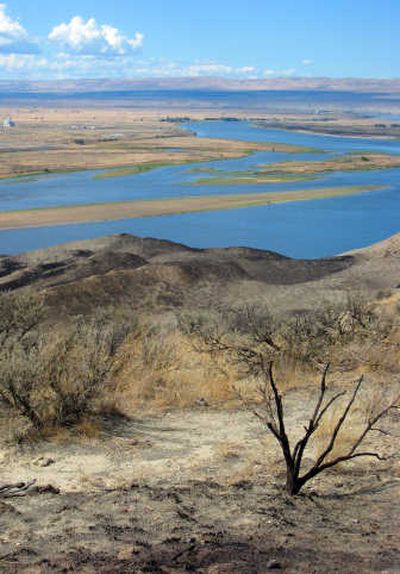Series of Hanford fires claim wildlife habitat

HANFORD REACH NATIONAL MONUMENT, Wash. – When wildfires raced through tinder-dry grass and sagebrush on the Hanford Reach National Monument this summer, much of the worry centered on whether flames would reach radioactive waste at the neighboring Hanford Nuclear Reservation.
Now wildlife officials are taking stock of the devastation to the charred monument itself, which stretches along a free-flowing stretch of the Columbia River known for salmon runs, bird habitat and rare plant life.
“The No. 1 threat to this monument was fire, and No. 2 is invasive species, which follows fire,” said Greg Hughes, who manages the monument for the U.S. Fish and Wildlife Service. “If we don’t rehabilitate this land now, we only increase the risk for more wildfires in the future.”
Fires have blackened 121 square miles of the monument this summer – more than 40 percent of the land area.
“On the north shore of the Columbia River, the Overlook fire torched 21,083 acres. Firefighters were able to save the old blacksmith shop, a log building near the White Bluffs Boat Lunch, but wildlife habitat wasn’t so lucky. Among the casualties: a heron rookery and prime sagebrush habitat for the endangered pygmy rabbit.
“With no sagebrush in that area now, it’ll be decades before we can even think about assisting with the recovery,” wildlife biologist Heidi Newsome said of the tiny, 1-pound rabbits.
“Another 4,800 acres burned on the Arid Lands Ecology Reserve, which has been considered one of the few large, contiguous blocks of arid shrub-steppe habitat remaining in the Northwest. The reserve used to be part of the Hanford nuclear site and has been closed to the public for decades. Firefighters were able to pinch off the fire before it spread too far, but then …
“On Aug. 16, high winds pushed flames from private land onto the reserve, blackening 51,000 acres on the monument alone. Most of the acreage already had burned in a massive fire in 2000, shortly after President Clinton designated the 193,000 acres in an almost horseshoe shape as a national monument. But plantings to rehabilitate the land after that fire went up in smoke this summer.
Newsome found the damage to natural resources depressing on a recent tour of the area. The wide expanse of charred acreage still smelled smoky, weeks after the fire, and only pockets of native grasses and sagebrush escaped the flames.
Sagebrush doesn’t re-sprout after fire, and it grows very slowly, needing about 30 years to mature enough to begin to provide habitat for certain species, Newsome said. They include the sage grouse, which is a threatened species in Washington, as well as sage sparrows, the sage thrasher, sagebrush vole and sagebrush lizard.
Even elk base their movement patterns on what cover they can get from the wind, such as from sagebrush. The monument supports more than 600 elk, but with much of their rangeland burned, wildlife experts are concerned they will be driven to farmers’ property or the neighboring Hanford site for food.
“Definitely after the 2000 fire, their use patterns changed to areas where there were still remaining sagebrush cover,” Newsome said.
Erosion is always a concern after a fire, and an even greater worry is the spread of noxious weeds and exotic plants, such as Russian thistle. Already, cheatgrass seeds litter the ashy soil up and down the monument, waiting to take over the land.
Between 2000 and 2006, some 90,000 acres of the monument burned. Those repeated fires, in conjunction with invasive species, prevent the area from restoring itself naturally, Newsome said.
“It’s not just the fires now. It’s the cumulative impact of these fires over time,” Newsome said. “The frequency and intensity of fires pose a threat to native grasses and shrubs in shrub-steppe habitat.”
Hanford Reach officials have proposed a $6.1 million recovery plan for part of the monument, though they aren’t proposing to treat, or reseed, all the burned land. Rather, they aim to protect those areas that could recover on their own.
Hughes maintains that the recovery effort is essential not just for wildlife habitat, but also for wildfire prevention.
“If we end up watching this go back to a weed patch, years later, you’ll see an increase in fire intensity, frequency, rate of spread, and maybe we won’t catch the next one,” he said.
Where there was rehabilitation work from previous fires, the flames spread more slowly this summer, proving the need for work this time around, Hughes said.